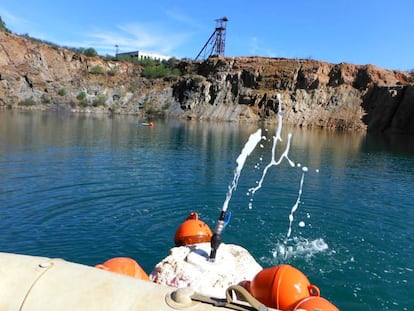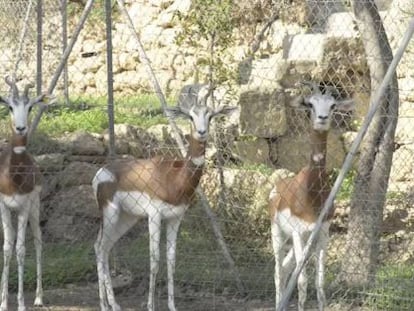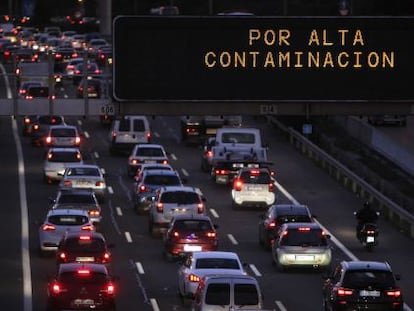The danger hiding under Spain’s ‘killer lake’
Huge amounts of carbon dioxide are trapped under water in former mine in Huelva

The scene on the afternoon of August 21, 1986 in Cameroon’s northeast was idyllic: the crystal blue waters of Lake Nyos in the crater of an extinct volcano in glittered in the sun. Then, without warning, a deadly cloud rose from the lake’s calm surface, spreading out across nearby villages, leaving 1,700 people dead in its wake and killing thousands of head of livestock.
The cloud was made of concentrated carbon dioxide, which devoured the oxygen in the atmosphere, leaving villages strewn with the corpses of people and animals. Two years earlier at neighboring Lake Monoun, 37 people died in similar circumstances.
Javier Sánchez España, a geochemist at Spain’s Institute of Geology and Mining says these are the only two episodes of limnic eruptions – or “exploding lake phenomena” – recorded to date.
Initially, the threat is not to Puebla de Guzmán's 3,000 inhabitants, but to the people who might be in the immediate vicinity of such an eruption
But he and his team of scientists have now discovered that the Corta Guadiana lake near the tiny community of Puebla de Guzmán, in Huelva province has the potential to expel a similarly lethal cloud from its depths. Sitting at the bottom of lake is 80,000m3 of carbon dioxide, which is seeping up from volcanic magma below.
“It’s a serious danger to the public,” says Sánchez whose team has published a report in Science of the Total Environment magazine. Initially, the threat is not to Puebla de Guzmán's 3,000 inhabitants, but to the people who might be in the immediate vicinity of such an eruption.
La Corta Guadiana is a peaceful spot with a history stretching back to 1893 when British mining company Bedel Metal & Chemical drilled down into the subsurface of the nearby Las Herrerías area in search of iron sulfide. After 1912, the mine was taken over by French company Saint Gobain and, in 1951, it fell into the hands of Herrerías Sociedad Anónima, which now belongs to BBVA bank and the Sundheim family. In the late 1980s, as Spain’s mining sector underwent reconversion, the pit was abandoned.
The legacy is an artificial lake, measuring 17,500 m2 and with a maximum depth of 68 meters and a high concentration of minerals. On the lake bed there are 2.5 liters of CO2 dissolved in every liter of water.
Thanks to the water pressure, the gas is trapped but the situation could change in the event of a landslide, as happened in Cameroon. And according to Sánchez España’s study, the steep walls of the open cast pit are highly unstable.

Sánchez has dived to the bottom of the Corta Guidiana lake with Bertram Boehrer, an expert from the Helmholtz Center of Environment Research in Magdeburg, Germany and a co-author of the report. “We were scared at first,” admits Sánchez. “We didn’t know what we would find or what the chances were of our tests provoking a limnic eruption. It’s the first time this phenomenon has been discovered in Europe. The only precedents are the two lakes in Africa,” he adds.
Besides the two lakes in Cameroon, there is a third potentially explosive lake called Kivu between Rwanda and the Democratic Republic of the Congo. The lake gained notoriety in 1994 when victims of the Rwandan genocide were dumped in it. Sánchez España says there is a strong possibility of a limnic eruption there.
For the moment, if there were an incident at Corta Guadiana, says Sánchez España, a suffocating cloud of concentrated carbon dioxide would rise around five meters above the surface of the lake, which would not be high enough to rise above the walls of the pit. But anybody inside the wire that once fenced off the mine would be in danger. Which is why the gas has to be removed.
Sánchez España says Institute of Geology and Mining is about to sign an agreement with the management of the regional government-run mining company to eliminate the gas stored in the lake. He says to do so it will cost €8,000 to anchor a 90-millimeter diameter pipe to the lake floor so that the gas can be released gradually over the course of nine months. His team has already experimented with a pilot pipe.
“We are not losing sleep over it but we do want to know what happens, “ says José Suárez, president of a local association that is trying to regain control of the mining heritage of Puebla de Guzmán.
Suárez was born just 100 meters from the Corta Guadiana lake and worked in mining all his life until his recent retirement. He say his dream is to set up a museum in the mining complex around Spain’s ‘killer lake’.
Sign up for our newsletter
EL PAÍS English Edition has launched a weekly newsletter. Sign up today to receive a selection of our best stories in your inbox every Saturday morning. For full details about how to subscribe, click here
English version by Heather Galloway.
Tu suscripción se está usando en otro dispositivo
¿Quieres añadir otro usuario a tu suscripción?
Si continúas leyendo en este dispositivo, no se podrá leer en el otro.
FlechaTu suscripción se está usando en otro dispositivo y solo puedes acceder a EL PAÍS desde un dispositivo a la vez.
Si quieres compartir tu cuenta, cambia tu suscripción a la modalidad Premium, así podrás añadir otro usuario. Cada uno accederá con su propia cuenta de email, lo que os permitirá personalizar vuestra experiencia en EL PAÍS.
¿Tienes una suscripción de empresa? Accede aquí para contratar más cuentas.
En el caso de no saber quién está usando tu cuenta, te recomendamos cambiar tu contraseña aquí.
Si decides continuar compartiendo tu cuenta, este mensaje se mostrará en tu dispositivo y en el de la otra persona que está usando tu cuenta de forma indefinida, afectando a tu experiencia de lectura. Puedes consultar aquí los términos y condiciones de la suscripción digital.
More information
Últimas noticias
The complicated life of Francesca Albanese: A rising figure in Italy but barred from every bank by Trump’s sanctions
From digital curfews to blocking apps: How technology experts protect their children online
Why the price of coffee has skyrocketed: from Brazilian plantations to specialty coffee houses
Confined to a Cuban hospital: When electricity is a matter of life or death
Most viewed
- Pablo Escobar’s hippos: A serious environmental problem, 40 years on
- Why we lost the habit of sleeping in two segments and how that changed our sense of time
- Trump’s obsession with putting his name on everything is unprecedented in the United States
- Charles Dubouloz, mountaineering star, retires at 36 with a farewell tour inspired by Walter Bonatti
- The Florida Keys tourist paradise is besieged by immigration agents: ‘We’ve never seen anything like this’











































